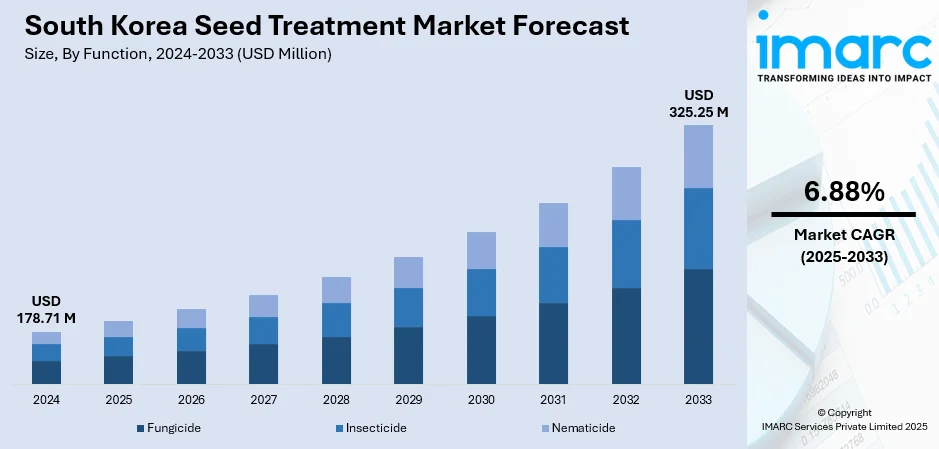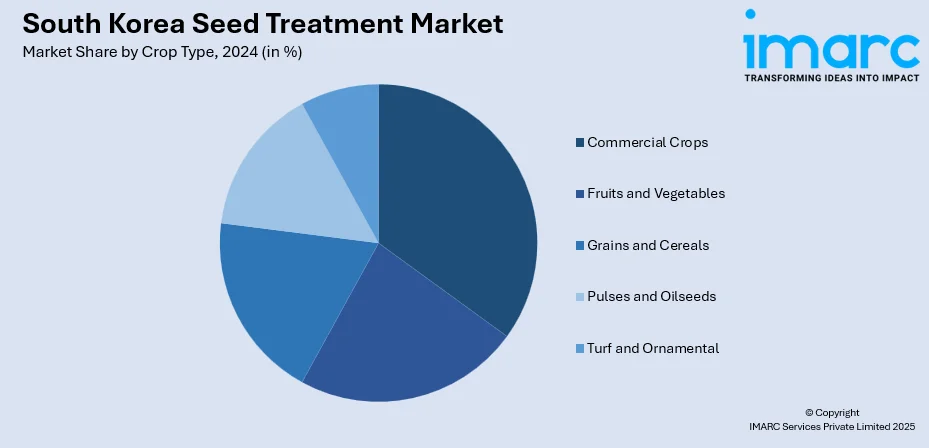
South Korea Seed Treatment Market Size, Share, Trends and Forecast by Function, Crop Type, and Region, 2026-2034
South Korea Seed Treatment Market Overview:
The South Korea seed treatment market size reached USD 178.71 Million in 2025. Looking forward, the market is expected to reach USD 325.25 Million by 2034, exhibiting a growth rate (CAGR) of 6.88% during 2026-2034. The market is prompted by the increasing demand for greater agricultural productivity, and support from the government for precision and sustainable agriculture, which pushing farmers toward adopting treated seeds with improved germination, resistance to diseases, and yields. Improvements in biotechnology and robust public-private R&D partnerships also drive innovation in seed coating, biologicals, and microbials. Compatibility of treated seeds in smart farming systems guarantees compatibility in controlled environments such as greenhouses and vertical farms, further contributing to the growth of the South Korea seed treatment market share.
|
Report Attribute
|
Key Statistics
|
|---|---|
|
Base Year
|
2025
|
|
Forecast Years
|
2026-2034
|
|
Historical Years
|
2020-2025
|
| Market Size in 2025 | USD 178.71 Million |
| Market Forecast in 2034 | USD 325.25 Million |
| Market Growth Rate 2026-2034 | 6.88% |
South Korea Seed Treatment Market Trends:
Technological Innovation in Seed Protection
The seed treatment industry of South Korea is marked by a robust shift toward the use of advanced materials and formulations, combining chemical, biological, and non-chemical methods to improve seed performance. Chemical seed coatings such as fungicidal and insecticidal films remain predominant, owing to their assured protection from pests and pathogens during the germination and seedling stages. Nevertheless, South Korea is also observing an increasing adoption of biological seed treatments. These green alternatives tap into useful microorganisms like bacteria and fungi, in order to enhance the health and resistance of plants, as part of the country's overall trend toward sustainable farming. The outcome is a symbiotic relationship between well-proven chemical supplements and green biological technologies, sustained both by farmer choice and regulatory policies that promote lowered chemical applications and environmental management.

To get more information on this market, Request Sample
Government Policy and Smart Farming Integration
South Korea has a unique emphasis on the government's facilitating role in stimulating seed-treatment uptake through smart farming and agricultural modernization policies. Government strategies encouraging smart-greenhouses, vertical crops, and precision cultivation directly align with needs for treated seeds optimized for these settings. Subsidies for and grants to adopt smart farm technology, like IoT-based greenhouses and AI-driven crop care, facilitate seed development with specially designed treatments that thrive under controlled-environment conditions. This coupling of seed-treatment technology and digital agriculture, supported by heavy government investment, is uniquely Korean, and speeds the movement toward more robust, higher-yielding crops adapted to high-density and urban farming, which further propels the South Korea seed treatment market growth.
Export Demand and Agricultural Competitiveness
The market for seed treatment in South Korea is also influenced by its position as a reliable supplier of sustainable and high-quality seeds on the world export stage. With scarce arable land and an ageing farm population, South Korea gives top priority to seed performance to enhance food security and increase productivity. Genetically enhanced and microbiologically treated seeds are developed for the twin purposes of augmenting domestic yields and conforming to international standards in overseas markets. Particularly, locally developed national brands in rice and vegetable seeds attributable to expert treatments that have been tailored to local varieties, have earned a quality reputation in neighboring nations. This export-oriented seed treatment ecosystem is supported through public-private partnerships and R\&D collaborations, ensuring that South Korean seeds remain competitive both at home and abroad.
South Korea Seed Treatment Market Segmentation:
IMARC Group provides an analysis of the key trends in each segment of the market, along with forecasts at the country and regional levels for 2026-2034. Our report has categorized the market based on function and crop type.
Function Insights:
- Fungicide
- Insecticide
- Nematicide
The report has provided a detailed breakup and analysis of the market based on the function. This includes fungicide, insecticide, and nematicide.
Crop Type Insights:

- Commercial Crops
- Fruits and Vegetables
- Grains and Cereals
- Pulses and Oilseeds
- Turf and Ornamental
The report has provided a detailed breakup and analysis of the market based on the crop type. This includes commercial crops, fruits and vegetables, grains and cereals, pulses and oilseeds, and turf and ornamental.
Regional Insights:
- Seoul Capital Area
- Yeongnam (Southeastern Region)
- Honam (Southwestern Region)
- Hoseo (Central Region)
- Others
The report has also provided a comprehensive analysis of all the major regional markets, which include Seoul Capital Area, Yeongnam (Southeastern Region), Honam (Southwestern Region), Hoseo (Central Region), and others.
Competitive Landscape:
The market research report has also provided a comprehensive analysis of the competitive landscape. Competitive analysis such as market structure, key player positioning, top winning strategies, competitive dashboard, and company evaluation quadrant has been covered in the report. Also, detailed profiles of all major companies have been provided.
South Korea Seed Treatment Market News:
- In June 2025, South Korea introduced a digital breeding platform to enhance the competitiveness of seeds. This innovative digital breeding information platform seeks to enhance the nation's standing within the worldwide seed market.
South Korea Seed Treatment Market Report Coverage:
| Report Features | Details |
|---|---|
| Base Year of the Analysis | 2025 |
| Historical Period | 2020-2025 |
| Forecast Period | 2026-2034 |
| Units | Million USD |
| Scope of the Report | Exploration of Historical Trends and Market Outlook, Industry Catalysts and Challenges, Segment-Wise Historical and Future Market Assessment:
|
| Functions Covered | Fungicide, Insecticide, Nematicide |
| Crop Types Covered | Commercial Crops, Fruits and Vegetables, Grains and Cereals, Pulses and Oilseeds, Turf and Ornamental |
| Regions Covered | Seoul Capital Area, Yeongnam (Southeastern Region), Honam (Southwestern Region), Hoseo (Central Region), Others |
| Customization Scope | 10% Free Customization |
| Post-Sale Analyst Support | 10-12 Weeks |
| Delivery Format | PDF and Excel through Email (We can also provide the editable version of the report in PPT/Word format on special request) |
Key Questions Answered in This Report:
- How has the South Korea seed treatment market performed so far and how will it perform in the coming years?
- What is the breakup of the South Korea seed treatment market on the basis of function?
- What is the breakup of the South Korea seed treatment market on the basis of crop type?
- What is the breakup of the South Korea seed treatment market on the basis of region?
- What are the various stages in the value chain of the South Korea seed treatment market?
- What are the key driving factors and challenges in the South Korea seed treatment market?
- What is the structure of the South Korea seed treatment market and who are the key players?
- What is the degree of competition in the South Korea seed treatment market?
Key Benefits for Stakeholders:
- IMARC’s industry report offers a comprehensive quantitative analysis of various market segments, historical and current market trends, market forecasts, and dynamics of the South Korea seed treatment market from 2020-2034.
- The research report provides the latest information on the market drivers, challenges, and opportunities in the South Korea seed treatment market.
- Porter's five forces analysis assist stakeholders in assessing the impact of new entrants, competitive rivalry, supplier power, buyer power, and the threat of substitution. It helps stakeholders to analyze the level of competition within the South Korea seed treatment industry and its attractiveness.
- Competitive landscape allows stakeholders to understand their competitive environment and provides an insight into the current positions of key players in the market.
Need more help?
- Speak to our experienced analysts for insights on the current market scenarios.
- Include additional segments and countries to customize the report as per your requirement.
- Gain an unparalleled competitive advantage in your domain by understanding how to utilize the report and positively impacting your operations and revenue.
- For further assistance, please connect with our analysts.
 Request Customization
Request Customization
 Speak to an Analyst
Speak to an Analyst
 Request Brochure
Request Brochure
 Inquire Before Buying
Inquire Before Buying




.webp)




.webp)












